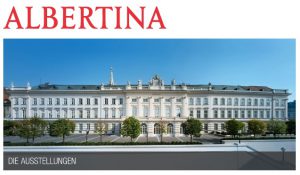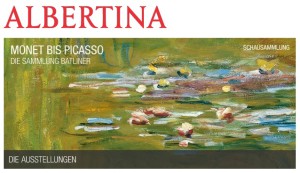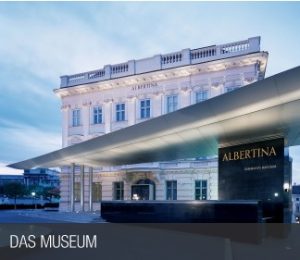The Albertina in Vienna, Austria
 With one of the largest print collections in the world, an impressive array of modern art, staterooms harkening back to the Habsburg days, and breathtaking temporary exhibitions, the Albertina is one of Vienna’s top attractions. The permanent modern exhibition of “Monet to Picasso” spans from Impressionist art to the 1960s.
With one of the largest print collections in the world, an impressive array of modern art, staterooms harkening back to the Habsburg days, and breathtaking temporary exhibitions, the Albertina is one of Vienna’s top attractions. The permanent modern exhibition of “Monet to Picasso” spans from Impressionist art to the 1960s.
The history of the Albertina and the print collection
The Albertina became a host of fine artworks in 1802, during a time when resident Duke Albert of Saxony-Teschen, the governor of the Habsburg Netherlands, was amassing an impressive collection that would be gathered for over 50 years. Duke Albert’s artistic treasures included 14,000 drawings and 200,000 prints of European artworks from the 15th to the 19th centuries. Many renditions by Dutch and Flemish artists graced his collection. Some artists represented include Leonardo da Vinci, Michelangelo, Raphael, Albrecht Durer and Rembrandt van Rijn. The graphic art collection now features 50, 000 drawings and watercolors and includes 900,000 prints ranging from the Late Gothic era to contemporary times. Modern artists represented in the collection include Egon Schiele, Gustav Klimt and Oskar Kokoschka.
The departure of the last Habsburg resident
In 1919, after the Habsburg Monarchy fell apart and the palace became the property of the newly-established Republic of Austria, the last Habsburg resident Archduke Friedrich had to leave and took his exquisite furnishings with him. The then empty rooms were used as exhibition halls and a library, for instance. The museum would wind up gathering more than 70 pieces of the staterooms’ original furniture from places all over the world.
The 20th century: bombing and reconstruction
The 20th century was not so kind to the museum. From 1934 to 1945 the collection was centered on Austrian and German graphic art from the 19th and 20th centuries. The palace was bombed during World War II in March of 1945. Reconstructed after the war, the Albertina was completely renovated from 1998 to 2003. The staterooms were in poor condition as of 1950. They were reconstructed in 2000 and opened in 2003. The graphics collection reopened in 2008 after a vast restoration process.
The Batliner Collection
 In 2007 the Batliners gave the museum more than 300 modern paintings. The Batliner Collection boasts many works by Pablo Picasso, including his ceramics. Other artists represented are Claude Monet, Henri Matisse, Edgar Degas, Max Ernst, Edward Munch, Marc Chagall, and George Braque. In 2008 almost 70 drawings, watercolors, and paintings by Paul Klee were donated to the museum, adding to an already impressive array of significant modern works.
In 2007 the Batliners gave the museum more than 300 modern paintings. The Batliner Collection boasts many works by Pablo Picasso, including his ceramics. Other artists represented are Claude Monet, Henri Matisse, Edgar Degas, Max Ernst, Edward Munch, Marc Chagall, and George Braque. In 2008 almost 70 drawings, watercolors, and paintings by Paul Klee were donated to the museum, adding to an already impressive array of significant modern works.
Some works in the Batliner Collection
Monet’s panoramic “View of Vetheuil” (1881) has a photographic quality in its portrayal of the village so poetically and masterfully rendered. Degas’s canvas “Two Dancers” (1905) emphasizes the frothy texture of the tutus with pale blue as the dominant color. In his “Young Woman in a Shirt” (1918) Amedeo Modigliani portrays a Renaissance-type figure. She appears to be anonymous as the artist emphasizes her body rather than her face. Ernst’s painting “Flowers on a Yellow Ground” (1929) depicts bluish and grayish shapes that possess a mysterious, mystical quality. Munch’s portrayal of the mist-ridden Norwegian landscape in “Winter Landscape” (1915) speaks of loneliness and alienation. Two colorful works by Czech artist Frantisek Kupka belong to the collection as well. Take a look at Picasso’s “Pots and Lemon.” The sharp-edged objects are simple yet exotic, displaying characteristics of Primitivism. In Picasso’s “Still Life with Guitar,” (1942) a dagger reminds the viewer of war while the olive and wine glass bring to mind more tranquil themes. The collection also features Picasso’s ceramics, inspired by ancient Greek artifacts. “Corrida” (1957) portrays a bullfight in the middle while the plate itself stands for the arena.
The staterooms
Visitors gain insight into the private and public lives of Habsburg leaders who had resided in this palace by touring the 21 ornate Neoclassical staterooms that were restored in 2000. The breathtaking interiors feature the Hall of the Muses, a former dining room with five crystal chandeliers as well as stucco marble wall panels and pilasters. Decorating the lavish room are the colossal statues of Apollo and the nine muses. Another treat is the dazzling Spanish Apartments. In 1895 Archduke Friedrich had the seven rooms making up the Spanish Apartments built for the Spanish royal family as their seat away from Spanish territory. Original furnishings speckle these spaces. Do not overlook the impressive, handmade emerald green wallpaper on the walls of the Oval Cabinet.
Other collections in the Albertina
The Albertina holds other valuable collections, too. A wealth of architectural material is stored in the museum as well. Approximately 50,000 plans, sketches, and models make up the collection that includes materials by Adolf Loos and models by Le Corbusier and Miles van der Rohe. The photographic collection goes as far back as the middle of the 19th century.
Important additional information
 It is possible to research the collections online. Guided tours of the Habsburg staterooms and Batliner Collection are available for groups and individuals. The permanent collection of “Monet to Picasso” is closed from September 2013 to January of 2014. Part of the collection will be on display at the Kunstmuseum Liechtenstein, and another part will be shown at the Hermitage in St. Petersburg, Russia.
It is possible to research the collections online. Guided tours of the Habsburg staterooms and Batliner Collection are available for groups and individuals. The permanent collection of “Monet to Picasso” is closed from September 2013 to January of 2014. Part of the collection will be on display at the Kunstmuseum Liechtenstein, and another part will be shown at the Hermitage in St. Petersburg, Russia.




